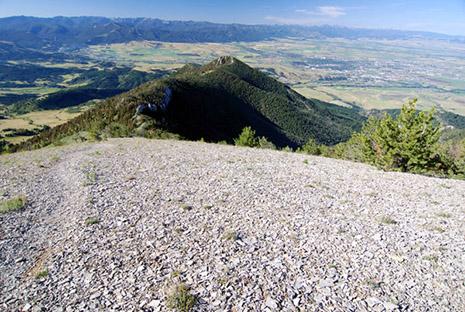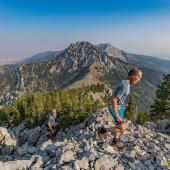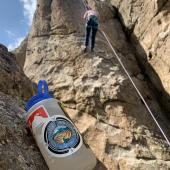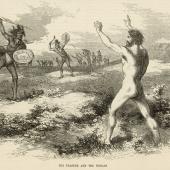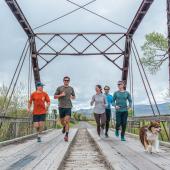Lessons Learned on the Bridger Ridge
Adrenaline pumped through my body as I took my first step on the infamous Bridger Ridge Run. The runners in the front set the pace for a long climb up the narrow path up Sacajawea Peak. I blew past the aid station and onto the loose shale field, trying to remember to stay low and confident as I stumbled and surfed down the jagged rocks. I reached the descent to the Bridger Foothills Trail before Ross Pass, leaning forward yelling, “I can’t stop!” After taking a two-week sick-break, my legs felt fresh and ready to tackle the trail. I reached the halfway point at Bridger Bowl after a long blackout climb, thrilled to see friends cheering me on.
My impromptu aid crew replenished my snacks, filled my water, and pumped me full of positive comments—I was halfway home! But what started as nervous excitement and adrenaline quickly devolved into physical and mental anguish once I hit Saddle Peak. I may not be the fastest or strongest runner, but I pride myself on usually staying positive during physical toil. During the climb up Saddle, I felt doubt seeping into my mind. Pain, hurt, tired, I can’t, I can’t, I can’t. I saw other runners stumbling from fatigue and exhaustion, barely holding themselves upright. Only I could finish this race; no one else was going to run it for me. You've trained eight months for this. Don’t give up… don’t give up…
Unexpectedly, the only thing that kept me plugging away toward my goal of finishing the Ridge Run was the running community. Prior to this experience, I felt alone every time I ran a race, as though the other runners were against me. In a ploy to spread my name all over town with the hopes of getting into the Ridge Run I joined the Big Sky Wind Drinkers. I arrived at my first BSWD “fun run” with excitement and a little bit of arrogance; That guy over there? Gotta be at least 65, old fogie. That woman? She’s pushing a baby carriage. I can beat ‘em all, no sweat. I got schooled. In my delusional moment of glory I forgot that Bozemanites are athletic and endurance freaks! I pushed my pride aside and mingled afterwards, finding the nicest group of people, genuinely excited to meet a new runner and provide some wisdom. From then on I no longer felt a ‘them versus me’ anguish, but rather a ‘We’re in this together’ type of bond.
That bond helped me when I neared the top of Saddle Peak out of breath, out of hope, and ready to lose my lunch. I had run into a fellow Wind Drinker near Ross Pass, whom I had met only a week prior. We vowed to stick together and motivate each other until the finish line. “You’re almost there, one foot in front of the next,” she kept telling me as I hunched over close to the ground, only steps away from the summit of Saddle Peak. Throughout the entire race, six grueling hours of pumping myself full of cheesy mantras, racers cheered one another on despite their own level of pain and suffering. We reached Saddle Peak to be greeted by some ambitious hikers with noisemakers and Oreos. My mood elevated but quickly deflated, a common roller-coaster trend over the course of 20 miles: I can do this! I’m giving up. I feel great! I want to die. After Sacajawea Peak I can’t say I actually had “fun” for the remaining five hours, but the race taught me a lot about what physical toil I’m willing to go through and even gave me time to reflect on why the hell I was running in the first place.
Even though it may feel as though everyone runs with painless ease, this is not the case. It's true that distance runners—especially Montana distance runners—are a different breed, but there are plenty of people out there who are not headed for the Olympics, and who worked just as hard as you to cross the finish line in one piece.
Physically, you're ready; it’s the mental aspect that will either propel you or slow you down. I had to repeat this to myself and my running partner over and over again on top of the Ridge. Once your mind wanders to the dark side it becomes easy to believe the race is just too physically difficult. Learn how to overcome those mental barriers and remind yourself, I have trained hard for this and I know what I’m doing.
I gave up running with music long ago because every time my iPod landed on a crappy song, (I swear I didn’t upload Jessica Simpson,) it would distract me from a natural rhythm. I started to run with my own wandering thoughts, which turned to travel, food, writing, and the 28 year-old quest for the meaning of life—all topics I could rarely find time to explore in the day-to-day grind. Learning to be alone for long periods of time can be hard to adapt to, but a vital tool for this sport.
So there I was, finally at the top of Baldy with five miles of downhill ahead of me. My legs had turned to pudding pops and I had to stop myself from swearing in front of the children at the aid station as I thought about giving up. Luckily, due to the nature of the course, I reminded myself I had nowhere else to go but onward. As I crossed the finish line, 5 hours and 52 minutes from the start, I didn’t have the cathartic feeling I was expecting, or an overwhelming sense of relief or accomplishment. I just wanted to sit down and drink a Coke. It was over. In the days to follow I was blindsided by feelings of post-race depression: what next? No more strict diet, no more training schedules, no more obsessing over injuries and sore muscles. At a time I should have felt relief I felt lost. People asked me dozens of times, “Do you think you’ll do it again?” Like a person returning from a life-changing trip abroad, I can’t find the words to answer that question. I have no idea if I’ll tackle the Ridge Run again, or if I’ll even race again, but I must remind myself that, due to the nature of the course, I have nowhere else to go but onward.


